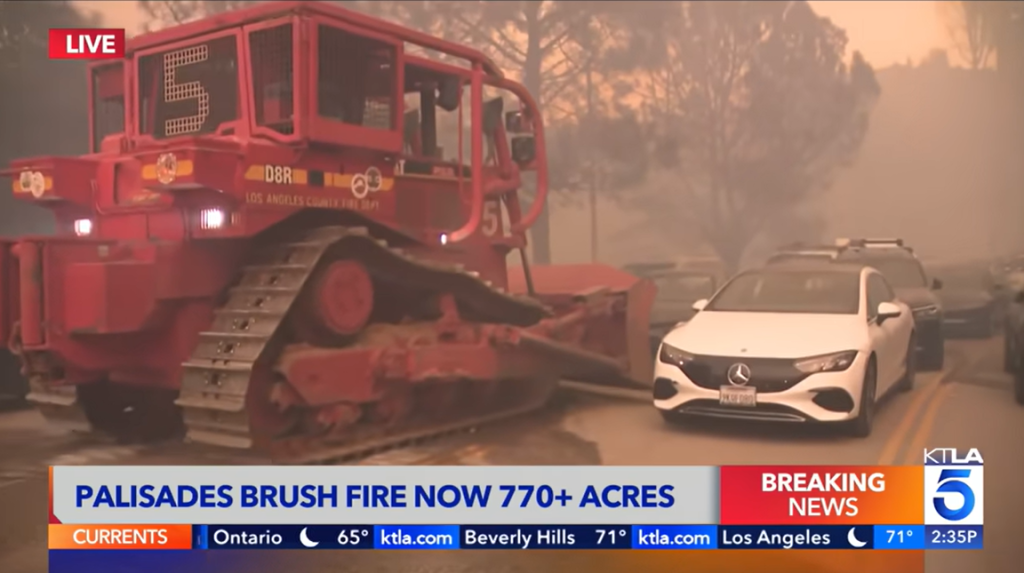For the Press:
Auto dependency and resilience
In January 2025, UCLA researchers published TRACtion: A collaborative, community-researcher agenda-setting approach in the journal Transportation Research Interdisciplinary Perspectives. The article describes a research agenda produced by a collaboration of researchers and community leaders that is more focused on people and equity versus other transportation research. During the collaborative process and, participants identified auto dependency as a resilience challenge for cities:
“Resilient cities have a strong capacity to endure disasters and other system shocks; they tend to be reflective, robust, redundant, flexible, resourceful and inclusive. Dependence on cars, however, leaves cities vulnerable to crises. For example, it leaves few options for evacuation in case of fuel shortages or road blockages, or for people who do not drive.” (TRACtion research agenda page 63)
The academic article’s appendix includes a section of prior research on auto dependency and resilience, including car-centric evacuations and multi-modal evacuation planning. This review of prior research, conducted in summer 2023, offers insights into evacuations from wildfires.

Caption: Image of a Los Angeles County Fire bulldozer moving abandoned cars to provide access to the Palisades fire.
Credit: Screen capture from LA TV station KTLA 5 via YouTube
Expert Contacts

Adam Millard-Ball
Director and Professor of Urban Planning
adammb@ucla.edu
For inquiries on street connectivity

Juan Matute
Deputy Director
jmatute@ucla.edu
For inquiries on car-centric evacuations, multi-modal evacuation planning, rebuilding from disasters
Auto dependency and resilience
Car-centric evacuations:
Personal vehicles are currently an integral part of evacuation planning. Driving enables those with access to a car to escape a crisis such as an impending hurricane or wildfire. People who depend on transit are left vulnerable (Bish 2011; PolicyLink, n.d.). Even for people able to evacuate by car, traffic congestion during evacuations can become deadly and impede first responders (Ahmad et al. 2023). Fuel shortages are another vulnerability (Gao et al. 2010). The growing adoption of EVs presents different challenges, including the potential for electric power shortages, outages, and insufficient range (Feng et al. 2020). Evacuation planning and policy has not yet caught up to EV adoption – for example, EV charging stations along major evacuation routes are often not subject to the same back-up power requirements as gasoline stations (Adderly et al. 2018).
Street connectivity:
The design of neighborhood street networks in Los Angeles may have played a critical role in exacerbating the impacts of the January 2025 fires. Circuitous, winding streets through hillside canyons — often with only a single exit to a main highway — created dangerous bottlenecks during emergency evacuations. With no alternative to driving, residents were funneled through a limited number of choke points, leading to gridlock. At one such location, Palisades Drive and Sunset Boulevard, people abandoned their cars amidst the chaos. New research on street network connectivity finds that many of the worst-affected neighborhoods during these fires have some of the least connected street networks in Los Angeles County. These areas feature more cul-de-sacs, circuitous routes, and subdivisions with just one or two escape routes. Poor street connectivity doesn’t just impede evacuation efforts — it also entrenches car dependence and undermines urban resilience in the face of crises.
Multi-modal evacuation planning:
Interconnected, multi-modal evacuation systems that include pedestrian, rail, aircraft, and bus evacuation routes are more resilient in an emergency (Xu and Chopra 2023). Local network models help planners identify weaknesses and improve infrastructure design to speed up evacuations (Blum and Eskandarian 2004). However, many evacuation models and plans still focus on cars (Hess and Gotham 2007). Bus evacuations can be more efficient and equitable compared to personal vehicles, particularly for hurricanes and other events that offer advance warning, but require significant resources, sufficient vehicles, and advance planning (Bish 2011).
Rebuilding from disasters:
In the wake of disasters, restoring transportation infrastructure to previous standards reinforces existing vulnerabilities and inequities (Boakye et al. 2022). Communities have the opportunity to re-build in a more sustainable, resilient, and equitable manner. However, reaching a consensus of what building back “better” means planning ahead of time is key to successful recoveries (Su and Le Dé 2020). After a disaster strikes, there is a relatively short period of time to create radical change (Platt 2017). For example, Christchurch, New Zealand attempted a community re-envisioning process in the wake of devastating earthquakes, but there were challenges in process and governance, with multiple levels of government creating plans that did not always align (Gjerde 2017).
Citations
Adderly, Shawn A., Daria Manukian, Timothy D. Sullivan, and Mun Son. 2018. “Electric Vehicles and Natural Disaster Policy Implications.” Energy Policy 112 (January):437–48. https://doi.org/10.1016/j.enpol.2017.09.030.
Ahmad, Salman, Asad Ali, Hafiz Usman Ahmed, Ying Huang, and Pan Lu. 2023. “Evaluating Traffic Operation Conditions during Wildfire Evacuation Using Connected Vehicles Data.” Fire 6 (5): 184. https://doi.org/10.3390/fire6050184.
Bish, Douglas R. 2011. “Planning for a Bus-Based Evacuation.” OR Spectrum 33 (3): 629–54. https://doi.org/10.1007/s00291-011-0256-1.
Blum, J.J., and A. Eskandarian. 2004. “The Impact of Multi-Modal Transportation on the Evacuation Efficiency of Building Complexes.” In Proceedings. The 7th International IEEE Conference on Intelligent Transportation Systems (IEEE Cat. No.04TH8749), 702–7. https://doi.org/10.1109/ITSC.2004.1398987.
Boakye, Jessica, Roberto Guidotti, Paolo Gardoni, and Colleen Murphy. 2022. “The Role of Transportation Infrastructure on the Impact of Natural Hazards on Communities.” Reliability Engineering & System Safety 219 (March):108184. https://doi.org/10.1016/j.ress.2021.108184.
Feng, Kairui, Ning Lin, Siyuan Xian, and Mikhail V. Chester. 2020. “Can We Evacuate from Hurricanes with Electric Vehicles?” Transportation Research Part D: Transport and Environment 86 (September):102458. https://doi.org/10.1016/j.trd.2020.102458.
Gao, Yang, Yi-Chang Chiu, Shuo Wang, and Simge Küçükyavuz. 2010. “Optimal Refueling Station Location and Supply Planning for Hurricane Evacuation.” Transportation Research Record 2196 (1): 56–64. https://doi.org/10.3141/2196-06.
Gjerde, Morten. 2017. “Building Back Better: Learning from the Christchurch Rebuild.” Procedia Engineering, Urban Transitions Conference, Shanghai, September 2016, 198 (January):530–40. https://doi.org/10.1016/j.proeng.2017.07.108.
Hess, Daniel Baldwin, and Julie C. Gotham. 2007. “Multi-Modal Mass Evacuation in Upstate New York: A Review of Disaster Plans.” Journal of Homeland Security and Emergency Management 4 (3). https://doi.org/10.2202/1547-7355.1317.
Platt, Stephen. 2017. “Factors Affecting the Speed and Quality of Post-Disaster Recovery and Resilience.” In Earthquake Engineering and Structural Dynamics in Memory of Ragnar Sigbjörnsson: Selected Topics, edited by Rajesh Rupakhety and Símon Ólafsson, 369–403. Geotechnical, Geological and Earthquake Engineering. Cham: Springer International Publishing. https://doi.org/10.1007/978-3-319-62099-2_19.
PolicyLink. n.d. “Car Access.” National Equity Atlas. https://nationalequityatlas.org/indicators/Car_access.
Su, Yvonne, and Loïc Le Dé. 2020. “Whose Views Matter in Post-Disaster Recovery? A Case Study of ‘Build Back Better’ in Tacloban City after Typhoon Haiyan.” International Journal of Disaster Risk Reduction 51 (December):101786. https://doi.org/10.1016/j.ijdrr.2020.101786.
Xu, Zizhen, and Shauhrat S. Chopra. 2023. “Interconnectedness Enhances Network Resilience of Multimodal Public Transportation Systems for Safe-to-Fail Urban Mobility.” Nature Communications 14 (1): 4291. https://doi.org/10.1038/s41467-023-39999-w.
For Reporters on Deadline:
Claudia Bustamante, Communications Manager
424-259-5486 / claudb@ucla.edu

